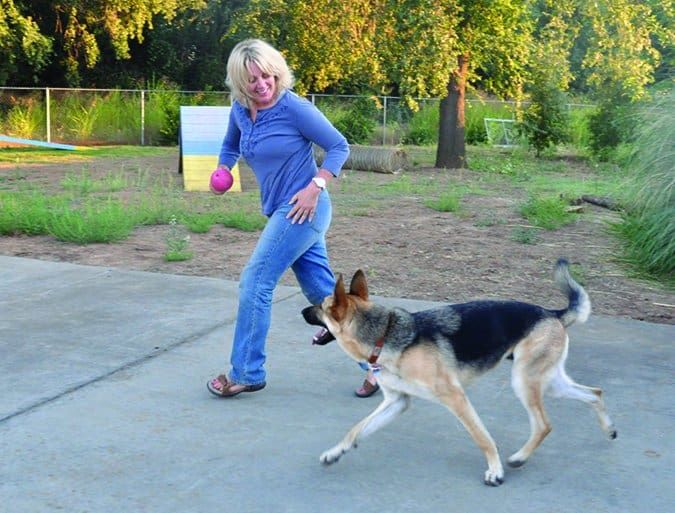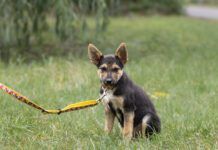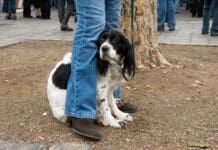
An increasing percentage of clients are bringing dogs to me for help with fear-related behaviors. Many of my fellow behavior professionals agree: They, too, are seeing more fearful dogs than they used to.
The increase in clients seeking help could be because more people are realizing that it might be possible to modify their dogs’ fearful behaviors.
However, it might also be because more shelters and rescue groups are rehoming fearful dogs who, in the past, would have been euthanized as “not adoptable.”
Many of us trainers also have been called upon to help owners with extremely undersocialized and fearful dogs imported from elsewhere, such as the Chinese and Korean meat-market dogs and “street dogs” brought here from Puerto Rico, Mexico, and elsewhere.
Whatever the reason for the seeming increase in the population of fearful dogs, good behavior professionals will do their best to help these dogs (and their humans) have a better quality of life – and there definitely are things that can help.
Differentiating Between Fear, Phobia, and Anxiety
In order to successfully modify fear-related behaviors, it’s important to understand the difference among the closely related behaviors of fear, phobia, and anxiety.

Fear is defined as an unpleasant emotion caused by the belief that someone or something is dangerous, likely to cause pain, or a threat. Most of us who have had dogs with fear issues (or are fearful ourselves) can agree, especially with the “unpleasant emotion” part. We tend to think of fear as a bad thing, but fear is also a life-preserving response to physical and emotional danger. If we didn’t feel fear, we would likely fail to protect ourselves from certain threats.
Phobia is an exaggerated, persistent, excessive fear of a particular object, class of objects, or situation. Common canine phobias include loud noises (thunder, gunshots, fireworks, household sounds), intense fear of humans, and riding in cars.
Anxiety is the anticipation of future dangers from unknown or imagined origins that result in normal body reactions (known as physiologic reactions) associated with fear. Fears and phobias occur in the presence of the emotion-causing stimuli, but dogs who are anxious present emotional and physiological fear responses even in the absence of the stimulus.
Of the three “shades” of fearful behaviors, the best prognosis is for dogs dealing with fear. At least we’re working with something real and present, rather than something exaggerated or imagined! A fearful dog may have significant behavioral responses, including a lowered body posture, trembling, salivating, hiding, fleeing, growling, snapping, biting, shutting down, and more.
Phobias and anxieties can also manifest in these behaviors, but also may include more extreme panicked responses such as jumping through windows, chewing through walls, urinating, defecating, and worse. Dogs with true phobias and anxieties often require pharmaceutical intervention before any modification efforts can even begin to be successful. (See “What About Drugs?” below.)
If you think your dog’s emotional responses go beyond fear into phobia or anxiety territory, please seek the help of a qualified behavior professional and a behavior-savvy veterinarian.
As a non-veterinary behavior professional, it is inappropriate for me to suggest specific behavior modification drugs to my clients or to our WDJ readers. Medication can and does have a vital role in behavior modification, however, and I have – on many occasions – suggested that my clients discuss behavior medications with their veterinarians. Here’s the rub: Most veterinary schools don’t require their students to take a single course in behavior, and the field of behavioral medicine is a complex one that most vets know very little about.
Here’s the solution. There are now about 70 veterinary behaviorists in the U.S., and many of them will generously do phone consults with general practitioners to help guide appropriate selection and dosage of behavior medications. Some offer this service to other veterinarians for free, others charge a reasonable fee for their time.
In any case, when I do ask my clients to discuss medications with their vets, I urge them to ask their veterinarian to take advantage of this service in order to ensure they are getting the best advice regarding pharmaceuticals. This helps to avoid the bad experiences some clients have (“the drug turned my dog into a zombie, or made her worse”) when well-meaning but uninformed veterinarians select an inappropriate medication or an improper dosage.
A complete list of board-certified veterinary behaviorists can be found here. If medication is in the cards for your fearful dog, urge your veterinarian to make use of this resource.
Preventing Fear in Dogs
My students have all heard me say this before: “We’re always better off preventing unwanted behaviors than we are trying to fix them.” Here’s another of my favorites: “Behavior is always a combination of genetics and environment.” A good fear-prevention program recognizes both – hence the importance of breeding behaviorally solid dogs as well as proper puppy socialization. Of course, you will also need to diligently protect your dog from traumatic events throughout her life.
If you raise two puppies – one genetically confident, one genetically fearful – in the exact same environment, giving them equal socialization, the odds are very good that the genetically solid pup will turn out just fine, while the one that came from a line of fearful dogs will likely be fearful.
Since many puppies come from shelters and rescue groups with little or no information about their genetic background, and because even good breeders sometimes receive unexpected rolls of the genetic dice, the best approach is to socialize every puppy properly, extensively, and thoroughly. Poorly socialized fearful dogs can be helped and their behavior improved upon, but will probably never be the dogs they could have been if they’d had a better start in life.

The puppy’s environment – even in utero – has as large an influence on him as his genetics. We now know that puppies born to mothers who were significantly stressed during pregnancy are likely to suffer from fear and stress-related behaviors throughout their lives, due to the flood of cortisol they were subjected to while still in the womb. Note to shelters and rescue groups: This means you need to work very hard to place your pregnant dogs in appropriate foster homes, rather than subjecting them to the stress of a shelter or kennel, to give those pups the best chance for a long and happy fear-free life.
Puppies observe and learn from their mothers, so if their mother is fearful, they learn this from her as well. It’s no wonder that recent studies suggest that puppy-mill puppies have significantly more and greater behavioral issues throughout their lives than dogs born in more suitable environments.
Significant life events can create fear in an otherwise confident adult dog, even one who is genetically sound and well-socialized. These events may have the biggest impact during puppyhood and adolescence, but can also cause fear later in life. A car accident can cause a previously car-loving dog to become fearful of cars. A single significant attack by another dog can turn a canine-loving hound into one who is fearful and defensively aggressive toward other dogs. And inappropriate actions by other humans toward your dog can convince her that people should be feared.
So the better you are at protecting your dog throughout her life from events that cause her to become significantly afraid, the less likely you will need to manage and/or modify her fear behaviors at some point. And, with a “get back on the horse” recommendation, science suggests that the sooner you work to modify a negative association (fear) due to a traumatic event, the more successful the modification efforts are likely to be.
Managing Your Dog’s Fear
I’m sorry if this sounds daunting, but in order to successfully modify fear-based behavior, you must painstakingly manage your dog’s exposure to the fear-causing stimulus.
Every time your dog has an over-threshold (fear-causing) exposure it can sensitize her further, making it even harder to convince her that she doesn’t need to be afraid. Barking, lunging, hiding, running away: whatever her avoidance strategies may be, each time she employs them she will become even more convinced that the strategies are effective, because she didn’t get injured or killed. Those behaviors are negatively reinforced (her behavior made a bad thing go away), and behaviors that are reinforced persist and increase.
If you want her to get more confident and less fearful, you must control your dog’s environment to protect her from the things that frighten her. Be your dog’s invincible advocate. If your dog is afraid of strangers, you must vehemently prohibit strangers from approaching her, even the sweet little lady who insists, “It’s okay, dogs love me!”
If your dog is fearful of visitors, put her in a safe place before anyone arrives – shut in a back bedroom, or even at a friend or family member’s house so she’s far away from the action, not trapped in a crate in the corner of the living room where guests can frighten her even more. Avoid taking her places where fear-causing sights or sounds might occur, and use appropriate medications to help her deal with scary situations that you cannot avoid, like trips to the veterinary clinic.
Modifying Your Dog’s Fear
So, how do you help your fearful dog get brave? My favorite approach is tried-and-true counter-conditioning and desensitization (CC&D): giving your dog a new, happier association with the scary stimulus. CC&D is simple and straightforward, and after a training/coaching session, my clients are usually able to practice successfully on their own, without me holding their hand every step of the way. (For a sample CC&D protocol for desensitizing your dog, see here.)

There are even more simple exercises you can use to help your dog maintain her equilibrium while you are working with your preferred behavior modification protocol. Many of these involve “priming” – putting your dog’s brain in a happy place by asking her to do something she loves so she can more easily cope with the stress of the fear-causing stimulus. Here are some examples:
Targeting
It may sound like a marketing technique, but it simply means teaching your dog to touch a designated body part to a designated target. That description doesn’t do it justice – targeting is tons of fun! Nose-targeting draws your dog’s eye-contact and attention from a worrisome stimulus to a pleasant one and can be very useful for timid dogs.
To teach it, hold your open palm in front of your dog, nose level or below. When she sniffs it (because she’s curious!), click your clicker and feed a treat (or use a verbal marker – a mouth click, or a word). Remove your hand, then offer it again.
Each time she sniffs, click and treat. If she stops sniffing (“Boring! I’ve already sniffed that!) rub a little tasty treat smell on the palm of your hand and try again. When she deliberately bumps her nose into your hand, add the “Touch!” cue as you offer your hand. Encourage her with praise and high-value treats. Make it a game, so her eyes light up when you say “Touch.”
When she loves the targeting game, try playing when your dog is a little nervous about something. Scary man passing by on the sidewalk? Hold out your hand and say “Touch!” Your dog takes her eyes – and brain – away from the scary thing and happily bonks her nose into your hand. Click and treat!
She can’t be afraid of the man and happy about touching your hand at the same time. And she can’t look at your target hand and stare at the scary man at the same time. By changing your dog’s behavior – having her do something she loves – you can manage a scary encounter and eventually change her association with something previously scary to her.

Find It
Like targeting, “Find it” is a behavior many dogs love and another game you can play to change behavior in the presence of a fear-causing stimulus.
With your dog in front of you, say “Find it!” in a cheerful tone of voice and toss a treat at your feet. When your dog finds the treat, click just before she eats it. Then say “Find it!” again and toss another at your feet. Click – and she eats the treat. Do this until your dog’s eyes light up and she looks toward your feet as soon as she hears the “Find it” cue.
Now when a scary skateboarder appears, say “Find It!” and toss treats at your feet. Your dog will take her eyes off the scary thing and switch into happy-treat mode. You’ve changed her emotion by changing her behavior.
These games can also work to walk your timid dog past a scary, stationary object, like a manhole cover, or a noisy air conditioning unit. Touch-and-treat as you walk past, or toss Find It treats on the ground ahead of you and slightly away from the scary thing, to keep her moving happily forward.

Play
You can use any behavior your dog already loves – a trick, toy, or game – to convince her that good things happen in the presence of something scary. If she loves to roll over, ask her to do that. If she delights in snagging tossed treats out of the air, do that. High five? Crawl? Spin and twirl? Do those.
The key to making any of these games work is to be sure you stay far enough away from the scary thing that your dog’s brain is able to click into “play” mode. You’ll be more successful if you start the games when you see low levels of stress, rather than waiting until she’s in full meltdown. If she’s too fearful, she won’t be able to play. If she’ll play games with you while the scary thing is at a distance, you’ll be able to move closer. If she stops playing and shuts down, you’ve come too close.
Be Patient and Kind to Fearful Dogs
Whatever protocol you use, always err on the side of caution, and remember that your canine pal is not being a “bad dog” – she is truly terrified. It should go without saying that any application of force, coercion, or punishment will only make things worse in the long run, even if it succeeds in shutting down behavior in the short term. With empathy, patience, and appropriate management and modification, you can help make your dog’s world a happier, safer place.






While clickers are great training tools, you should watch your dogs reaction to the clicker. With one of my dogs, his behavior got worse with a clicker. It turns out that he has some sounds sensitivity that I wasn’t aware of. When I switched to using a quiet marker, just a quiet “good”, some of his reactivity to stressors improved.